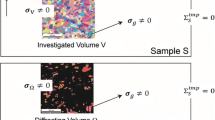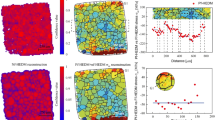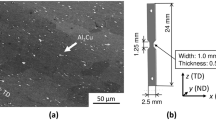Abstract
In this work, a study on the influence of morphologic texture on the residual stress determination by diffraction in metallic materials with cubic and hexagonal symmetry is proposed. To this end, elastic self-consistent model has been developed to properly take into account the morphologic texture. Extreme crystallites morphologies (sphere, disc and fibre) were studied, and coupled with the crystallographic texture to reflect the combined effect of morphologic and crystallographic texture in elasticity. In the case of morphologic texture, a stronger influence than the crystallographic texture on the estimated residual stresses (several tens of MPa difference) was observed. We propose a methodology through a scale transition model to take into account the influence of these different morphologies in the stress analysis by diffraction methods. The main purpose of this work was to make the best choice for lattice planes (hkl) used for residual or internal stress analysis, in elasticity, depending on the morphologic (and crystallographic) texture of the polycrystal, especially when the usual X-ray Elasticity Constants (XECs) are used instead of the stress factors.










Similar content being viewed by others
References
Reuss A (1929) Berechnung der Fließgrenze von Mischkristallen auf Grund der Plastizitätsbedingung für Einkristalle. ZAMM J Appl Math Mech/Zeitschrift für Angew Math und Mech 9:49–58
Hill R (1952) The elastic behaviour of a crystalline aggregate. Proc Phys Soc Sect A 65:349–353. doi:10.1088/0370-1298/65/5/307
Eshelby JD (1957) The determination of the elastic field of an ellipsoidal inclusion, and related problems. Proc R Soc Lond Ser A Math Phys Sci 241:376–396
Kröner E (1958) Berechnung der elastischen Konstanten des Vielkristalls aus den Konstanten des Einkristalls. Z für Phys 151:504–518
Hill R (1963) Elastic Properties of Reinforced Solids: Some Theoretical Principles. J Mech Phys Solids 11:357–372
Hill R (1964) Theory of mechanical properties of fibre-strengthened materials: i. elastic behaviour. J Mech Phys Solids 12:199–212
Hill R (1965) A self-consistent mechanics of composite materials. J Mech Phys Solids 13:213–222
Hauk V (1997) Structural and residual stress analysis by nondestructive methods. Elsevier, Amsterdam
Welzel U, Fréour S, Mittemeijer EJ (2005) Direction-dependent elastic grain-interaction models—a comparative study. Philos Mag 85:2391–2414. doi:10.1080/14786430500070685
Welzel U, Fréour S, Kumar A, Mittemeijer EJ (2006) Diffraction stress analysis of grain interaction in polycrystalline materials. Z für Krist S23:43–49
Welzel U, Kumar A, Mittemeijer EJ (2009) Extremely anisotropic, direction-dependent elastic grain interaction: The case of ultrathin films. Appl Phys Lett 95:111907. doi:10.1063/1.3224904
Fréour S, Lacoste E, François M, Guillén R (2011) Determining Ti-17 β-Phase single-crystal elasticity constants through X-ray diffraction and inverse scale transition model. Mater Sci Forum 681:97–102. doi:10.4028/www.scientific.net/MSF.681.97
Patoor E, Lagoudas DC, Entchev PB et al (2006) Shape memory alloys, Part I: general properties and modeling of single crystals. Mech Mater 38:391–429. doi:10.1016/j.mechmat.2005.05.027
Lacoste E, Fréour S, Jacquemin F (2010) On the validity of the self-consistent scale transition model for inclusions with varying morphologies. Mech Mater 42:218–226. doi:10.1016/j.mechmat.2009.10.002
Krier J, Ruppersberg H, Berveiller M, Lipinski P (1991) Elastic and plastic anisotropy effects on second order internal stresses in textured polycrystalline materials. Textures Microstruct 14–18:1147–1152
Hendrix BC, Yu LG (1998) Self-consistent elastic properties for transversely isotropic polycrystals. Acta Mater 46:127–135. doi:10.1016/S1359-6454(97)00261-9
Koch N, Welzel U, Wern H, Mittemeijer EJ (2004) Mechanical elastic constants and diffraction stress factors of macroscopically elastically anisotropic polycrystals: the effect of grain-shape (morphological) texture. Philos Mag 84:3547–3570
Fréour S, Gloaguen D, François M et al (2005) Determination of single-crystal elasticity constants in a cubic phase within a multiphase alloy: X-ray diffraction measurements and inverse-scale transition modelling. J Appl Crystallogr 38:30–37. doi:10.1107/S0021889804023441
Hofmann M, Wimpory RC (2009) NET TG1: residual stress analysis on a single bead weld on a steel plate using neutron diffraction at the new engineering instrument “STRESS-SPEC.”. Int J Press Vessel Pip 86:122–125. doi:10.1016/j.ijpvp.2008.11.007
Manns T, Scholtes B (2013) Diffraction residual stress analysis in technical components—status and prospects. Thin Solid Films 530:53–61. doi:10.1016/j.tsf.2012.03.064
Foss BJ, Gray S, Hardy MC et al (2013) Analysis of shot-peening and residual stress relaxation in the nickel-based superalloy RR1000. Acta Mater 61:2548–2559. doi:10.1016/j.actamat.2013.01.031
Barile C, Casavola C, Pappalettera G, Pappalettere C (2014) Analysis of the effects of process parameters in residual stress measurements on Titanium plates by HDM/ESPI. Measurement 48:220–227. doi:10.1016/j.measurement.2013.11.014
Baczmański A, Tidu A, Lipinski P et al (2006) New type of diffraction elastic constants for stress determination. Mater Sci Forum 524–525:235–240
Baczmański A, Lipinski P, Tidu A et al (2008) Quantitative estimation of incompatibility stresses and elastic energy stored in ferritic steel. J Appl Crystallogr 41:854–867. doi:10.1107/S0021889808023911
Kocks UF, Tomé CN, Wenk HR (1998) Texture and anisotropy: preferred orientations in polycrystals and their effect on materials properties. Cambridge University Press, Cambridge
Bunge H-J (1982) Texture analysis in materials science. Butterwort, London
Morris PR (1970) Elastic constants of polycrystals. Int J Eng Sci 8:49–61
Dölle H (1979) The influence of multiaxial stress states gradients and elastic anisotropy on the evaluation of residual stresses by X-rays. J Appl Crystallogr 12:489–501
Brakman CM (1983) Residual stresses in cubic materials with orthorhombic or monoclinic specimen symmetry: influence of texture on ψ splitting and non-linear behaviour. J Appl Crystallogr 16:325–340. doi:10.1107/S0021889883010511
Sprauel JM, Francois M, Barral M (1989) Calculation of X-ray Elastic Constants of Textured Materials Using Kroner Model. In: Beck G, Denis S, Simon A (eds) International Conference on Residual Stress. 2. Springer Netherlands, pp 172–177
Ortiz M, Pochettino AA, Lebrun JL, Maeder G (1991) X-ray elastic constants in textured titanium sheets and bars. Textures Microstruct 14–18:219–224
Ortiz M, Pochettino AA, Lebrun JL, Maeder G (1993) X-ray elastic constants in textured Zr-base materials. Metall Trans A 24:389–396
Gnäupel-Herold T, Brand PC, Prask HJ (1998) Calculation of single-crystal elastic constants for cubic crystal symmetry from powder diffraction data. J Appl Crystallogr 31:929–935. doi:10.1107/S002188989800898X
Nagashima S, Shiratori M, Fujiu T (1981) The estimation of elastic constans for the X-ray stress analysis of textured metallic materials. Proceedings of the 6th International Conference on Textures of Materials 2:1148–1156
Chung DH, Buessem WR (1967) The elastic anisotropy of crystals. J Appl Phys 38:2010–2012
Alers GA, Neighbours JR (1958) The elastic constants of the zinc between 4.2° and 670 °K. J Phys Chem Solids 7:58–64
Ledbetter HM (1977) Elastic properties of zinc: a compilation and a review. J Phys Chem Ref Data 6:1181–1203
Noyan IC, Cohen JB (1987) Residual stress—measurement by diffraction and interpretation. Springer-V, New York
Gloaguen D, Fajoui J, Girard E, Guillén R (2010) X-ray measurement of residual stresses and texture development during a rolling sequence of zirconium alloy cladding tubes—influence of plastic anisotropy on mechanical behaviour. J Appl Crystallogr 43:890–899
Zhang F, Vincent G, Sha YH et al (2004) Experimental and simulation textures in an asymmetrically rolled zinc alloy sheet. Scr Mater 50:1011–1015. doi:10.1016/j.scriptamat.2003.12.031
Van Swygenhoven H, Van Petegem S (2013) In-situ mechanical testing during X-ray diffraction. Mater Charact 78:47–59. doi:10.1016/j.matchar.2012.12.010
Cullity BD (1956) Elements of X-ray diffraction, Addison-Wesley
Dakhlaoui R, Braham C, Baczmański A (2007) Mechanical properties of phases in austeno-ferritic duplex stainless steel—surface stresses studied by X-ray diffraction. Mater Sci Eng A 444:6–17
Reimers W, Pyzalla AR, Schreyer A, Clemens H (2008) Neutrons and synchrotons radiation in engineering materials science. wiley-VCH, Weinheim
Clausen B, Lorentzen T, Leffers T (1998) Self-consistent modelling of the plastic deformation of f.c.c. polycrystals and its implications for diffraction measurements of internal stresses. Acta Mater 46:3087–3098. doi:10.1016/S1359-6454(98)00014-7
Gloaguen D, Oum G, Legrand V et al (2013) Experimental and theoretical studies of intergranular strain in an alpha titanium alloy during plastic deformation. Acta Mater 61:5779–5790
Muránsky O, Carr DG, Barnett MR et al (2008) Investigation of deformation mechanisms involved in the plasticity of AZ31 Mg alloy: in situ neutron diffraction and EPSC modelling. Mater Sci Eng A 496:14–24
Muránsky O, Barnett MR, Carr DG et al (2010) Investigation of deformation twinning in a fine-grained and coarse-grained ZM20 Mg alloy: combined in situ neutron diffraction and acoustic emission. Acta Mater 58:1503–1517
Faurie D, Renault P-O, Le Bourhis E, Goudeau P (2006) Study of texture effect on elastic properties of Au thin films by X-ray diffraction and in situ tensile testing. Acta Mater 54:4503–4513. doi:10.1016/j.actamat.2006.05.036
Brandes EA, Brook GB (1992) Smithells metals reference book, 7th edn. Butterworth-Heinemann, Bodmin
Dölle H, Cohen JB (1980) Evaluation of (residual) stresses in textured cubic metals. Metall Trans A 11:831–836
Taylor GI (1938) Plastic strain in metals. Twenty-eighth May Lect to Inst Met 307–325
Gloaguen D, Berchi T, Girard E, Guillén R (2007) Measurement and prediction of residual stresses and crystallographic texture development in rolled Zircaloy-4 plates: X-ray diffraction and the self-consistent model. Acta Mater 55:4369–4379
Renault P-O, Le Bourhis E, Villain P et al (2003) Measurement of the elastic constants of textured anisotropic thin films from X-ray diffraction data. Appl Phys Lett 83:473. doi:10.1063/1.1594280
Faurie D, Renault P-O, Le Bourhis E et al (2006) Elastic behavior of polycrystalline thin films inferred from in situ micromechanical testing and modeling. Appl Phys Lett 89:061911. doi:10.1063/1.2335779
Author information
Authors and Affiliations
Corresponding author
Rights and permissions
About this article
Cite this article
Hounkpati, V., Fréour, S., Gloaguen, D. et al. Influence of morphologic texture on stress analysis by X-ray and neutron diffraction in single-phase metallic materials. J Mater Sci 49, 7049–7065 (2014). https://doi.org/10.1007/s10853-014-8410-1
Received:
Accepted:
Published:
Issue Date:
DOI: https://doi.org/10.1007/s10853-014-8410-1




